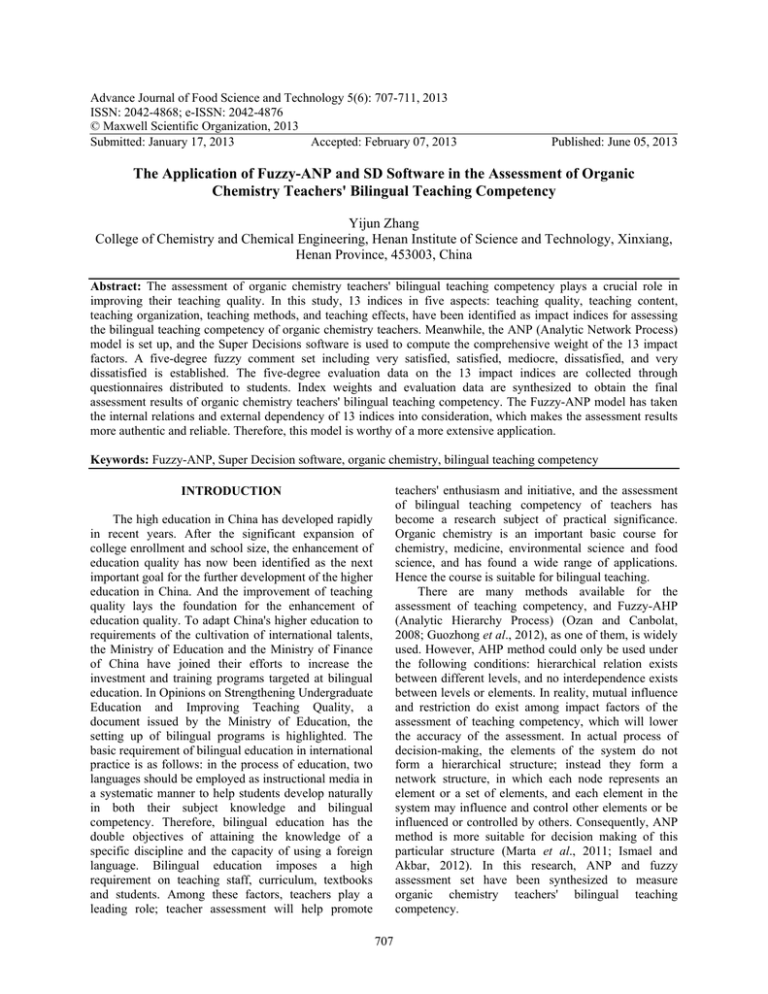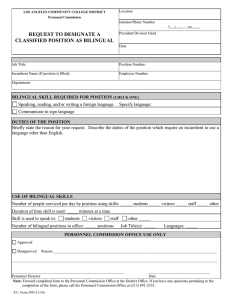Advance Journal of Food Science and Technology 5(6): 707-711, 2013
advertisement

Advance Journal of Food Science and Technology 5(6): 707-711, 2013
ISSN: 2042-4868; e-ISSN: 2042-4876
© Maxwell Scientific Organization, 2013
Submitted: January 17, 2013
Accepted: February 07, 2013
Published: June 05, 2013
The Application of Fuzzy-ANP and SD Software in the Assessment of Organic
Chemistry Teachers' Bilingual Teaching Competency
Yijun Zhang
College of Chemistry and Chemical Engineering, Henan Institute of Science and Technology, Xinxiang,
Henan Province, 453003, China
Abstract: The assessment of organic chemistry teachers' bilingual teaching competency plays a crucial role in
improving their teaching quality. In this study, 13 indices in five aspects: teaching quality, teaching content,
teaching organization, teaching methods, and teaching effects, have been identified as impact indices for assessing
the bilingual teaching competency of organic chemistry teachers. Meanwhile, the ANP (Analytic Network Process)
model is set up, and the Super Decisions software is used to compute the comprehensive weight of the 13 impact
factors. A five-degree fuzzy comment set including very satisfied, satisfied, mediocre, dissatisfied, and very
dissatisfied is established. The five-degree evaluation data on the 13 impact indices are collected through
questionnaires distributed to students. Index weights and evaluation data are synthesized to obtain the final
assessment results of organic chemistry teachers' bilingual teaching competency. The Fuzzy-ANP model has taken
the internal relations and external dependency of 13 indices into consideration, which makes the assessment results
more authentic and reliable. Therefore, this model is worthy of a more extensive application.
Keywords: Fuzzy-ANP, Super Decision software, organic chemistry, bilingual teaching competency
teachers' enthusiasm and initiative, and the assessment
of bilingual teaching competency of teachers has
become a research subject of practical significance.
Organic chemistry is an important basic course for
chemistry, medicine, environmental science and food
science, and has found a wide range of applications.
Hence the course is suitable for bilingual teaching.
There are many methods available for the
assessment of teaching competency, and Fuzzy-AHP
(Analytic Hierarchy Process) (Ozan and Canbolat,
2008; Guozhong et al., 2012), as one of them, is widely
used. However, AHP method could only be used under
the following conditions: hierarchical relation exists
between different levels, and no interdependence exists
between levels or elements. In reality, mutual influence
and restriction do exist among impact factors of the
assessment of teaching competency, which will lower
the accuracy of the assessment. In actual process of
decision-making, the elements of the system do not
form a hierarchical structure; instead they form a
network structure, in which each node represents an
element or a set of elements, and each element in the
system may influence and control other elements or be
influenced or controlled by others. Consequently, ANP
method is more suitable for decision making of this
particular structure (Marta et al., 2011; Ismael and
Akbar, 2012). In this research, ANP and fuzzy
assessment set have been synthesized to measure
organic chemistry teachers' bilingual teaching
competency.
INTRODUCTION
The high education in China has developed rapidly
in recent years. After the significant expansion of
college enrollment and school size, the enhancement of
education quality has now been identified as the next
important goal for the further development of the higher
education in China. And the improvement of teaching
quality lays the foundation for the enhancement of
education quality. To adapt China's higher education to
requirements of the cultivation of international talents,
the Ministry of Education and the Ministry of Finance
of China have joined their efforts to increase the
investment and training programs targeted at bilingual
education. In Opinions on Strengthening Undergraduate
Education and Improving Teaching Quality, a
document issued by the Ministry of Education, the
setting up of bilingual programs is highlighted. The
basic requirement of bilingual education in international
practice is as follows: in the process of education, two
languages should be employed as instructional media in
a systematic manner to help students develop naturally
in both their subject knowledge and bilingual
competency. Therefore, bilingual education has the
double objectives of attaining the knowledge of a
specific discipline and the capacity of using a foreign
language. Bilingual education imposes a high
requirement on teaching staff, curriculum, textbooks
and students. Among these factors, teachers play a
leading role; teacher assessment will help promote
707
Adv. J. Food. Sci. Technol., 5(6): 707-711, 2013
clusters and element nodes. Comparison matrix of
element nodes compares the importance of nodes
among the same clusters or nodes among different
clusters, and is also known as local dominance degree.
Comparison matrix of the clusters is called the weight
matrix; it compares the importance of different clusters
with respect to the overall objectives, and is also
referred to as global dominance degree. The local
dominance degrees of all nodes in a cluster relative to
the parent nodes in another cluster (including itself)
constitute the matrix assembly. Calculate the
comprehensive weight W of each impact factor
according to the matrix assembly.
W = {w1 , w2 ,..., wn }
Step 5: fuzzy comprehensive assessment.
Fig. 1: Assessment process
⎡ r11 r12
⎢r r
B = ( b1 , b2 ,..., bm ) = W o R = ( w1 , w2 ,..., wn ) o ⎢ 21 22
⎢ ... ...
⎢
⎣rn1 rn 2
METHODS
The main steps of assessment are as follows (İhsan
and Metin, 2010) (Fig. 1 and Step1-5):
Step 1: establish a set of assessment factors.
Let the set of assessment factors be U.
S = B.Med .vt
U = {u1 , u2 ,..., un }
APPLICATION OF THE ANP MODEL
Step 2: establish a comment set.
Let the comment set be V, and each degree of the
evaluation corresponds to a fuzzy subset.
V = {v1 , v2 ,..., vm }
The corresponding intermediate value Med.v
Med .v = {Med .v1 , Med .v 2 , ...,
Med .v m } .
Step 3: establish a fuzzy relational matrix.
Quantify each factor u according to the comment
set, i.e., use a single factor to determine the fuzzy
subordination degree between the assessed object and
each evaluation degree, and then get the fuzzy
relational matrix R.
⎡ r11
⎢r
R = ⎢ 21
⎢ ...
⎢
⎣ rn1
r12
r22
...
rn 2
... r1m ⎤
... r2m ⎥⎥
... ... ⎥
⎥
... rnm ⎦
... r1m ⎤
... r2 m ⎥⎥
... ... ⎥
⎥
... rnm ⎦ n× m
Step 4: Establish the ANP model and determine the
weight of the assessment factors set.
Build the ANP model which contains the control
layer and network layer: the control layer is composed
of several criteria, and the network layer is composed of
Set up assessment factor set and comment set: Based
on expert interviews and the principle of operability,
these research measures five aspects, namely, teaching
quality, teaching content, teaching organization,
teaching methods, and teaching effects. 13 indices are
ultimately selected to compose the set of assessment
factors (Table 1). The comment set is divided into five
degrees including very satisfied, satisfied, mediocre,
dissatisfied, and very dissatisfied, Vt={80<v1≤100,
60<v2≤80, 40<v3≤60, 20<v4≤40, 0<v5≤20}, with
corresponding intermediate value Med .v {90, 70, 50,
30, 10}.
Establish the ANP model: Establish the ANP model
(Fig. 2, 3) and calculate the weight of each assessment
factor by Super Decisions software (Ediz and Basar,
2012). These weights reflect quantitatively the degree
of mutual influence between impact factors in the
analysis model. The specific steps are as follows: use
design-cluster-new order to set up clusters, use designnode-new order to set up element nodes, and use do
connexions order to set up the internal connections
(internal dependency) within the same cluster as well as
connections (external dependency) among different
clusters. Use assess/compare-pairwise comparison
order to compare the relations between clusters and
element nodes on a 1-9 scale, and generate comparison
matrix. Comparison should be done in questionnaire
mode. Use computations-unweighted super matrix
order to calculate the unweighted super matrix of the
ANP model, in accordance with the comparison matrix;
708 Adv. J. Food. Sci. Technol., 5(6): 707-711, 2013
Table 1: Assessment index system
Target layer
Bilingual teaching competency (A)
Criteria layer
Teaching quality(B1)
Teaching content(B2)
Teaching organization(B3)
Teaching methods(B4)
Teaching effects(B5)
Sub-criteria layer
Proficiency of bilingual expression(B11)
The knowledge of a specific discipline(B12)
Teaching attitude(B13)
The targetedness of bilingual textbooks(B21)
The reasonability of the proportion of bilingual contents(B22)
The reasonability of the course contents(B23)
The reasonability of bilingual contents organization(B31)
The reasonability of time allocation(B32)
Bilingual ability to communicate(B41)
Teaching environment creation(B42)
Flexibility of methods(B43)
Students' mastery of subject knowledge(B51)
Students' improvement in their foreign language skills(B52)
Fig. 2: Assessment ANP model of organic chemistry teachers' bilingual teaching competency
Fig. 3: Assessment ANP model in Super Decision software
709 Adv. J. Food. Sci. Technol., 5(6): 707-711, 2013
Fig. 4: Limit super matrix in Super Decision software
this super matrix represents the degree of local
dominance of the corresponding element nodes, and the
sum of elements in columns in each matrix assembly is
1. Use computations-weighted super matrix order to
calculate the weighted super matrix, which represents
the degree of global dominance of the corresponding
element nodes, and the sum of elements in columns is
1. Use computations-limit matrix to calculate the limit
super matrix (Fig. 4), which is derived from doing
power operation on the weighted super matrix, and its
weighted value tends towards stability.
RESULTS AND ANALYSIS
Weights of indices (Table 2):
Survey results of students' satisfaction: In this study,
112 students are as respondents. The results of
questionnaire survey are shown in Table 3.
Comprehensive assessment results: Follow Step 5 to
calculate the assessment results of organic chemistry
teachers' bilingual teaching competency. The process is
as follows:
B = W o R = [ 0.0536 0.0327 0.0466 0.0176 0.0650 0.0364 0.0638
0.0249 0.0350 0.0211 0.0277 0.2333 0.3423
⎡0.5893
⎢0.6696
⎢
⎢ 0.7321
⎢
⎢0.8125
⎢0.8214
⎢
⎢0.7946
o ⎢0.6696
⎢
⎢0.8036
⎢0.7946
⎢
⎢0.8214
⎢
⎢ 0.6071
⎢0.7768
⎢
⎣0.8036
0.2143 0.1250 0.0446 0.0268.⎤
0.0714 0.1696 0.0625 0.0268 ⎥⎥
0.0893 0.1161 0.0446 0.0179 ⎥
⎥
0.0893 0.0714 0.0268 0.0000 ⎥
0.0625 0.0268 0.0446 0.0446 ⎥
⎥
0.1161 0.0714 0.0179 0.0000 ⎥
0.1964 0.0893 0.0446 0.0000 ⎥ = [ 0.7652 0.1273 0.0629 0.0270 0.0176 ]
⎥
0.1250 0.0179 0.0179 0.0357 ⎥
0.1339 0.0268 0.0089 0.0357 ⎥
⎥
0.1429 0.0089 0.0268 0.0000 ⎥
⎥
0.2500 0.0625 0.0714 0.0089 ⎥
0.1786 0.0268 0.0179 0.0000 ⎥
⎥
0.0804 0.0714 0.0179 0.0268 ⎦
S = B .Med .v = 0 .7652 × 90 + 0 .1273 × 70 + 0 .0629 × 50 + 0 .0270 × 30 + 0 .0176 × 10 = 81 .91
The comprehensive assessment of organic
chemistry teachers' bilingual teaching competency is
"good".
Table 2: Weights of indices
Index
B11
B12
B13
B21
B22
B23
B31
B32
B41
B42
B43
B51
B52
Table 3: Students' satisfaction of indices (Percentage)
Index
v1
v2
v3
v4
B11
58.93
21.43
12.50
4.46
B12
66.96
7.14
16.96
6.25
73.21
8.93
11.61
4.46
B13
81.25
8.93
7.14
2.68
B21
82.14
6.25
2.68
4.46
B22
79.46
11.61
7.14
1.79
B23
66.96
19.64
8.93
4.46
B31
80.36
12.50
1.79
1.79
B32
79.46
13.39
2.68
0.89
B41
82.14
14.29
0.89
2.68
B42
60.71
25.00
6.25
7.14
B43
77.68
17.86
2.68
1.79
B51
80.36
8.04
7.14
1.79
B52
Weight
0.0536
0.0327
0.0466
0.0176
0.0650
0.0364
0.0638
0.0249
0.0350
0.0211
0.0277
0.2333
0.3423
v5
2.68
2.68
1.79
0.00
4.46
0.00
0.00
3.57
3.57
0.00
0.89
0.00
2.68
CONCLUSION
The assessment of organic chemistry teachers'
bilingual teaching competency can be conducted in five
aspects, namely, teaching quality, content, organization,
methods and effects. And 13 indices are singled out to
compose the assessment factors set. The fuzzy
comment set is divided into five degrees including very
satisfied, satisfied, mediocre, dissatisfied, and very
dissatisfied.
Set up the Fuzzy-ANP model, which takes into
account of the internal and external dependency of
assessment factors, making the assessment results more
authentic and reliable.
710 Adv. J. Food. Sci. Technol., 5(6): 707-711, 2013
The extensive application of ANP used to be
impeded by its complex computation, but Super
Decisions software provides a solution. This lays the
foundation for the wide-ranging use of the ANP model,
and simplifies the assessment process of organic
chemistry teachers' bilingual teaching competency. The
comprehensive weight of the 13 indices can be obtained
by using the SD software. The assessment results,
synthesized in a fuzzy manner from the assessment
factor weight and assessment data, can provide
guidance for improving teaching quality.
ACKNOWLEDGMENT
This project is financially supported by the
Research Project on Education and Teaching of Henan
Institute of Science and Technology in 2007 (Project
Title: Bilingual Teaching Research and Practice of
Organic Chemistry) and Bilingual Demonstration
Course Project of Organic Chemistry of Henan Institute
of Science and Technology.
REFERENCES
Guozhong, Z., N. Zhu, Z. Tian, Y. Chen and B. Sun,
2012. Application of a trapezoidal fuzzy AHP
method for work safety evaluation and early
warning rating of hot and humid environments.
Safety Sci., 50(2): 228-239.
İhsan, Y. and D. Metin, 2010. Using the fuzzy Analytic
Network Process (ANP) for Balanced Scorecard
(BSC): A case study for a manufacturing
firm. Expert Syst. Appl., 37(2): 1270-1278.
Ismael, G. and N. Akbar, 2012. Evaluation of
harvesting methods for Sustainable Forest
Management (SFM) using the Analytical Network
Process (ANP). Forest Policy Econ., 21: 81-91.
Marta, B., E. Comino and V. Riggio, 2011. Application
of the analytic hierarchy process and the analytic
network process for the assessment of different
wastewater treatment systems. Environ. Modell.
Softw., 26(10): 1211-1224.
Ozan, C. and M.S. Canbolat, 2008. A web-based
decision support system for multi-criteria inventory
classification using fuzzy AHP methodology.
Expert Syst. Appl., 35(3): 1367-1378.
Ediz, A. and H.B. Basar, 2012. Evaluation of power
plants in Turkey using Analytic Network Process
(ANP), Energy Volume, 44(1): 555-563.
711





